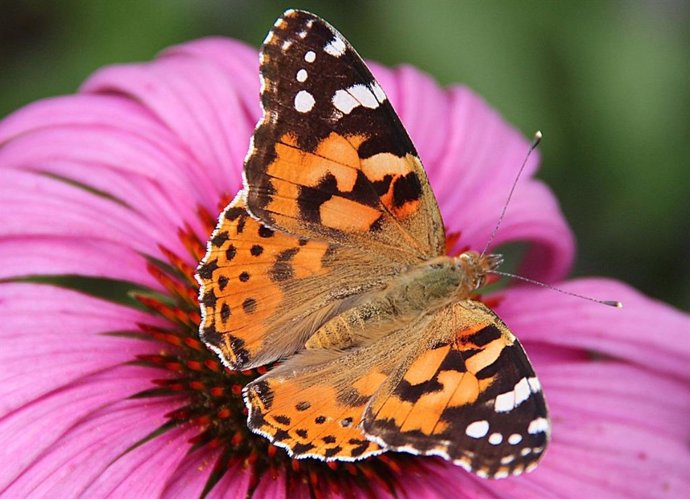Vanessa of the Thistles specimen – WIKIPEDIA
June 25 () –
Butterflies of the Vanessa thistle species discovered in French Guiana in 2013, and which are not common in South America, they arrived from Europe after crossing the Atlantic from Africa.
It is the conclusion of an international study that used innovative multidisciplinary tools to trace the 4,200 kilometer journey to the origin of those mysterious butterflies. Their results are published in the June 24 issue of Nature Communications.
First, the research team reconstructed wind trajectories for the period before these butterflies arrived in October 2013. They found exceptionally favorable wind conditions that could allow a transatlantic crossing from West Africa, which opens the possibility that these individuals could have flown across the entire ocean.
After sequencing the genomes of these individuals and analyzing them in comparison to global populations, the researchers discovered that the butterflies were most closely genetically related to African and European populations. This result eliminated the probability that these individuals came from North America, which reinforces the hypothesis of an ocean voyage.
The researchers took advantage of a unique combination of cutting-edge molecular techniques. They sequenced the DNA of the pollen grains carried by these butterflies. They identified two species of plants that only grow in tropical Africa, indicating that butterflies They drank nectar from African flowers before embarking on their transatlantic journey.
They analyzed hydrogen and strontium isotopes in butterfly wings, a chemical signal that acts as a “fingerprint” from the region of native origin. Combining isotopes with a model of habitat suitability for larval growth revealed a possible natal origin in Western Europe, possibly France, Ireland, the United Kingdom or Portugal.
Dr. Clement Bataille, Professor of Earth and Environmental Sciences at the University of Ottawa, who co-led the study, says: “This is the first time that this combination of molecular techniques including isotope geolocation and pollen metabolic barcoding has been test on migratory insects The results are very promising and transferable to many other species of migratory insects. “The technique should fundamentally transform our understanding of insect migration.”
“We usually see butterflies as symbols of the fragility of beauty, but science shows us that they can perform incredible feats. There is still much to discover about their capabilities,” says Roger Vila, researcher at the Institute of Evolutionary Biology (CSIC-Universidad Pompeu Fabra) and co-author of the study.
The researchers evaluated the feasibility of a transatlantic flight by analyzing the energy expenditure of the journey. They predicted that the flight over the ocean, lasting between five and eight days without stops, It was made possible by advantageous wind conditions.
“Butterflies could only have completed this flight using a strategy that alternated between active flight, which is energetically costly, and gliding with the wind. “We calculate that without wind, the butterflies could have flown a maximum of 780 km before consuming all their fat and, therefore, their energy,” says Eric Toro-Delgado of the Institute of Evolutionary Biology, another of the article’s co-authors.
Researchers highlight the Saharan air layer as an important aerial dispersal route. These wind currents are known to transport large amounts of Saharan dust from Africa to America, fertilizing the Amazon. This study now shows that These air currents are capable of transporting living organisms.
The potential impact of migrations in the context of global change This finding indicates that natural air corridors may exist connecting continents, which could facilitate the dispersal of species on a much larger scale than previously imagined.
“I think this study demonstrates well the extent to which we tend to underestimate the dispersal capabilities of insects. Furthermore, it is entirely possible that we also underestimate the frequency of these types of dispersal events and their impact on ecosystems,” says Megan Reich, postdoctoral fellow at the University of Ottawa and co-author of the study.
Gerard Talavera, discoverer of butterflies in 2013 and principal investigator of the study, adds: “Throughout history, migratory phenomena have been important in defining the distributions of species as we observe them today.”










![[Img #74661]](https://thelatestnews.world/wp-content/uploads/2024/12/The-power-of-ultrasound-150x150.jpg)



![[Img #74661]](https://thelatestnews.world/wp-content/uploads/2024/12/The-power-of-ultrasound-300x200.jpg)

Add Comment